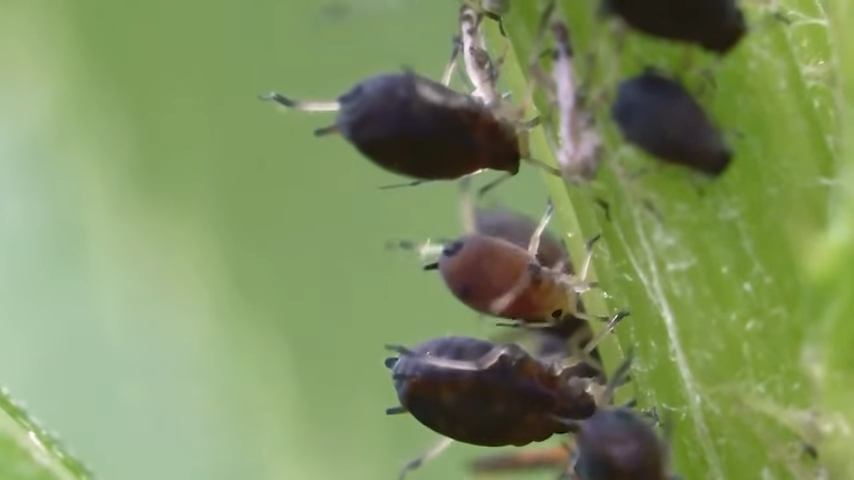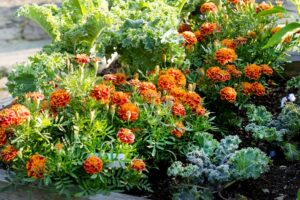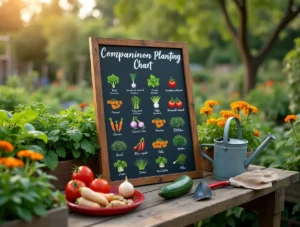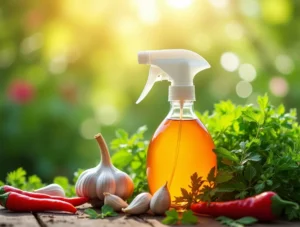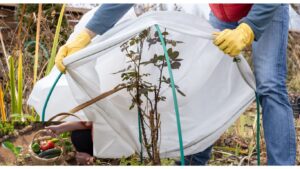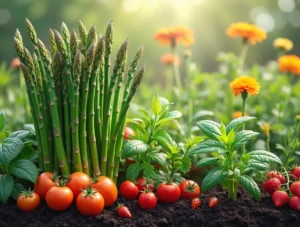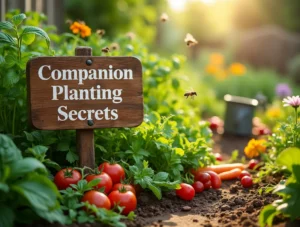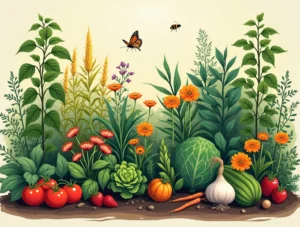If you’re tired of battling garden pests without resorting to harsh chemicals, it’s time to explore the power of companion plants for pest control . This age-old gardening technique uses natural pest control by strategically placing plants that deter bugs, attract beneficial insects, and support a balanced ecosystem in your garden.
In this companion gardening guide , we’ll walk you through 25 of the most effective companion plants for pest control , how they work, and where to plant them for maximum impact.
On This Page
What Is Companion Planting for Pest Control?
Companion plants for pest control are species grown together to naturally manage insect populations, boost pollination, and improve overall garden health. This form of pest control companion planting mimics nature’s own defense systems, helping your garden thrive without synthetic pesticides.
Also known as garden companion planting , this method not only keeps unwanted bugs at bay but also enhances soil fertility and supports a balanced ecosystem of pollinators and predatory insects.
Top 25 Companion Plants for Pest Control
Basil – Repels Mosquitoes, Aphids & Whiteflies
Basil is more than just a culinary staple — it’s one of the best plants for pest control . Its aromatic oils confuse and repel mosquitoes, aphids, and whiteflies. When planted near tomatoes, peppers, or eggplants, basil boosts their flavor and protects them from pests.
Grow basil in full sun and well-drained soil for best results.
Mint – Deters Ants, Flies & Mice
Mint, especially peppermint, helps keep ants, flies, spiders, and even mice away. Its strong scent masks nearby crops, making them less attractive to pests.

Because mint spreads quickly, consider planting it in containers or along garden borders.
Rosemary – Keeps Carrot Flies & Cabbage Loopers Away
Rosemary’s woody aroma makes it an excellent companion plant for pest control . It repels carrot flies, cabbage loopers, and mosquitoes while attracting bees and other pollinators.

Plant rosemary in sunny spots with well-drained soil and pair it with carrots, beans, broccoli, or cabbage.
Thyme – Fights Cabbage Worms & Aphids
Thyme releases aromatic oils that deter pests like cabbage worms, whiteflies, and aphids. It also attracts ladybugs and parasitic wasps — natural predators of many garden pests.

Use thyme as a ground cover between rows or around vegetable beds for added protection.
Lavender – Repels Moths & Mosquitoes
Lavender is not only beautiful and fragrant but also a powerful plant for pest control . Its essential oils repel moths, fleas, and mosquitoes, making it ideal for planting near roses, fruit trees, or seating areas.

Choose a sunny spot with good air circulation and avoid overwatering.
Marigolds – Natural Nematode Fighter
Marigolds are a top choice for companion plants for pest control . Their roots release a compound called alpha-terthiol, which deters nematodes and other soil-dwelling pests. They also repel aphids and beetles.
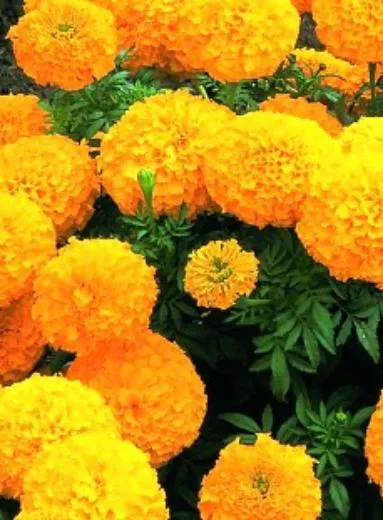
Plant marigolds around tomatoes, beans, or cucumbers to enjoy both beauty and protection.
Nasturtium – Lures Aphids Away
Nasturtiums act as a trap crop, luring aphids, squash bugs, and whiteflies away from your main crops. Plus, their edible flowers add color and flavor to salads.
They’re easy to grow in poor to average soil and prefer full sun.
Chrysanthemum – Contains Natural Insecticide (Pyrethrin)
Chrysanthemums contain pyrethrin, a natural compound used in many organic pest control companion plants . These flowers repel ants, roaches, ticks, and lice.
Place them around garden borders or near pest-prone areas for optimal effect.
Calendula – Traps Aphids and Repels Tomato Worms
Calendula (also known as pot marigold) acts as a decoy for aphids, drawing them away from your vegetables. It also repels tomato worms and attracts beneficial insects.
Start seeds indoors or sow directly after the last frost.
Petunias – Repel Bean and Tomato Pests
Petunias naturally repel pests that target beans, squash, and potatoes. They also attract hummingbirds and butterflies, supporting a balanced ecosystem .
Plant them near tomatoes, beans, and squash for dual benefits.
Garlic – Repels Aphids and Spider Mites
Garlic’s pungent aroma keeps aphids, Japanese beetles, spider mites, and even gophers away. It pairs well with roses, tomatoes, and peppers.
Avoid planting garlic near legumes, as they may compete for nutrients.
Onions – Keep Aphids and Rabbits Away
Onions deter aphids, Japanese beetles, and rabbits with their strong smell. Their presence can protect neighboring plants like tomatoes and carrots.
They grow best in full sun and loose, fertile soil.
Radishes – Trap Crop for Flea Beetles
Radishes attract flea beetles and other pests, drawing them away from leafy greens and brassicas. Their deep roots also break up compacted soil.
Sow radish seeds early and thin seedlings for best results.
Leeks – Repel Carrot and Onion Flies
Leeks mask the scent of neighboring plants and repel carrot and onion flies. They’re ideal companions for root vegetables.
Provide rich, well-drained soil and space them properly for healthy growth.
Chives – Natural Aphid Deterrent
Chives repel aphids, Japanese beetles, and some fungal infections. They’re especially helpful when planted near roses and fruit trees.
Harvest regularly to maintain their pest-repelling power.
Borage – Attracts Bees and Repels Hornworms
Borage repels tomato hornworms and cabbage worms while attracting bees and improving soil health by releasing nutrients.
Let borage self-seed for continuous growth year after year.
Dill – Lures Beneficial Insects
Dill attracts predatory insects like ladybugs and parasitic wasps. Its feathery foliage also repels squash bugs and cabbage moths.
Avoid planting dill near carrots to prevent cross-pollination issues.
Fennel – Attracts Ladybugs and Wasps
Fennel’s licorice-like scent repels slugs and snails. It also attracts ladybugs and parasitic wasps, which prey on aphids.
Plant fennel in dedicated spaces due to its allelopathic properties.
Catnip – Repels Flea Beetles and Ants
Catnip’s minty aroma repels flea beetles, ants, aphids, and squash bugs. It also attracts pollinators.
Grow catnip along garden borders or near brassicas.
Tansy – Deters Aphids and Beetles
Tansy repels aphids, ants, and beetles. It’s especially useful near beans, cabbage, and tomatoes.
Space tansy plants 18–24 inches apart to avoid overshadowing smaller plants.
Sunflowers – Trap Crop for Aphids and Caterpillars
Sunflowers lure aphids and caterpillars away from other crops. They also attract pollinators and birds that eat pests.
Plant them along garden edges to act as a natural barrier.
Zinnias – Attract Ladybugs and Parasitic Wasps
Zinnias attract beneficial insects like ladybugs, parasitic wasps, and lacewings. These predators help control aphids, whiteflies, and cabbage worms.
Deadhead spent blooms to prolong flowering and pest control.
Mustard Greens – Repel Aphids and Cabbage Worms
Mustard greens emit a pungent odor that deters aphids, cabbage worms, and flea beetles. They also belong to the brassica family, which naturally repels pests.
Plant mustard greens around tomatoes, cabbage, and broccoli.
Clover – Fixes Nitrogen and Attracts Beneficial Insects
Clover fixes nitrogen in the soil, enriches the soil, suppresses weeds, and attracts pollinators and predatory insects.
Use clover as a living mulch between rows or under fruit trees.
Buckwheat – Boosts Pollinators and Soil Health
Buckwheat attracts bees, hoverflies, and ladybugs. It also improves soil structure and acts as a cover crop.
Sow buckwheat between seasons or during crop rotations.
How to Use Companion Plants for Pest Control
To maximize the effectiveness of pest control companion :
- Intercrop pest-repelling plants with vulnerable crops.
- Use trap crops like radishes, sunflowers, and nasturtiums to draw pests away.
- Create living mulches using clover or buckwheat to suppress weeds and attract beneficial insects.
- Plant pest-repelling herbs and flowers around garden borders and among vegetables.
Companion Planting Chart :
| Companion Plant | Pests Repelled | Best Planted With | Additional Benefits |
|---|---|---|---|
| Basil | Mosquitoes, Aphids, Whiteflies | Tomatoes, Peppers, Eggplants | Enhances flavor; attracts pollinators |
| Mint | Flies, Ants, Spiders, Mice | Garden borders | Strong scent confuses pests; attracts bees |
| Rosemary | Carrot Flies, Cabbage Loopers, Mosquitoes | Carrots, Beans, Broccoli, Cabbage | Deters pests; drought-tolerant; attracts bees |
| Thyme | Cabbage Worms, Whiteflies, Aphids | Cabbage, Broccoli, Tomatoes | Attracts ladybugs and parasitic wasps |
| Lavender | Moths, Fleas, Mosquitoes | Roses, Fruit Trees | Repels pests; beautiful blooms; attracts pollinators |
| Marigold | Aphids, Whiteflies, Nematodes | Tomatoes, Beans, Cucumbers | Nematode-fighting roots; adds color |
| Nasturtium | Aphids, Squash Bugs, Whiteflies | Brassicas, Tomatoes, Cucumbers | Acts as trap crop; edible flowers |
| Chrysanthemum | Ants, Roaches, Ticks, Lice | Garden Borders | Contains natural insecticide (pyrethrin) |
| Calendula | Aphids, Tomato Worms | Tomatoes | Traps aphids; attracts beneficial insects |
| Petunias | Bean Beetles, Squash Bugs | Beans, Squash, Potatoes | Repels pests; attracts hummingbirds |
| Garlic | Aphids, Spider Mites, Japanese Beetles | Tomatoes, Roses, Peppers | Strong aroma deters pests; protects against disease |
| Onions | Aphids, Carrot Root Fly, Rabbits | Tomatoes, Carrots, Brassicas | Masks scent of crops; deters larger pests |
| Radishes | Flea Beetles | Leafy Greens, Brassicas | Trap crop; breaks up compacted soil |
| Leeks | Carrot Flies, Onion Flies | Root Vegetables | Confuses pests with mild sulfur scent |
| Chives | Aphids, Japanese Beetles | Roses, Tomatoes, Fruit Trees | Onion-like scent masks vulnerable plants |
| Borage | Tomato Hornworms, Cabbage Worms | Tomatoes, Strawberries | Attracts bees; improves soil health |
| Dill | Squash Bugs, Cabbage Moths | Cucumbers, Onions, Brassicas | Attracts ladybugs and wasps; repels pests |
| Fennel | Slugs, Snails | Border Gardens | Attracts ladybugs and wasps; allelopathic properties |
| Catnip | Flea Beetles, Ants, Aphids | Brassicas | Minty scent repels pests; attracts pollinators |
| Tansy | Aphids, Ants, Beetles | Beans, Cabbage, Tomatoes | Natural pest deterrent; grows tall |
| Sunflowers | Aphids, Caterpillars | Vegetables | Trap crop; attract birds and pollinators |
| Zinnias | Aphids, Whiteflies, Cabbage Worms | Vegetable Beds | Attract ladybugs, wasps, and butterflies |
| Mustard Greens | Aphids, Cabbage Worms, Flea Beetles | Tomatoes, Cabbage, Broccoli | Pungent odor repels pests; fast-growing |
| Clover | Various pests (indirectly) | Corn, Leafy Greens | Fixes nitrogen; living mulch; attracts pollinators |
| Buckwheat | Aphids, Caterpillars | Fruit Trees, Vegetable Beds | Attracts hoverflies and ladybugs; improves soil structure |
Final Thoughts: Build a Healthier Garden Naturally
companion plants for pest control offer a sustainable, eco-friendly way to protect your garden. By integrating these natural allies into your garden plan, you’ll encourage a balanced ecosystem , reduce reliance on chemical pesticides, and support natural pest control .
Whether you’re growing vegetables, herbs, or ornamentals, companion planting is a smart strategy for healthier, more productive plants.
FAQ
What companion plants keep bugs away?
Many plants that repel pests naturally can be used in your garden to protect crops without chemicals. These include basil , mint , rosemary , lavender , and marigolds — all excellent choices for natural pest control companion strategies. They either mask the scent of your vegetables, confuse pests with strong aromas, or attract beneficial insects like ladybugs and parasitic wasps.
These pest control companion gardening methods are easy to implement and support a healthier, more balanced garden ecosystem.
What plant keeps pests away naturally?
Several herbs and flowers serve as powerful natural pest control companions . Garlic, chives, onions, and catnip are especially effective due to their pungent smells, which deter aphids, Japanese beetles, flea beetles, and even small animals like rabbits and gophers.
By using these plants that repel pests in your companion gardening guide , you’ll reduce the need for synthetic pesticides while improving pollination and soil health.
What is the best flower for pest control?
Marigolds are often considered the top flower for pest control in pest control companion gardening systems. Their roots release a compound called alpha-terthiol , which deters nematodes, while their scent helps repel aphids, whiteflies, and beetles.
Other highly effective pest-repelling flowers include:
Nasturtiums – Trap crops for aphids and squash bugs
Chrysanthemums – Contain natural insecticides (pyrethrins)
Calendula – Repels tomato worms and attracts beneficial insects
Zinnias – Attract ladybugs and wasps that prey on pests
Including these in your companion gardening guide will help maintain a vibrant and healthy garden.
How does companion planting help with pests?
Companion planting is a proven natural pest control companion strategy that uses specific plant pairings to deter pests and improve garden health. Here’s how it works:
Repelling Pests : Certain plants emit scents that pests dislike, making it harder for them to locate and damage your crops.
Attracting Beneficial Insects : Flowers like buckwheat , clover , and dill draw in predatory insects such as ladybugs, lacewings, and parasitic wasps.
Trap Cropping : Plants like radishes , nasturtiums , and sunflowers lure pests away from valuable vegetables.
Masking Scents : Strong-smelling plants that repel pests, like garlic and onions, hide the scent of neighboring crops from insects.
Using this companion gardening guide allows you to grow a thriving garden with fewer chemicals and more biodiversity.
Want More Gardening Tips?
If you’re looking to expand your pest control companion gardening knowledge, explore our full companion gardening guide packed with tips on pairing plants for maximum growth, flavor enhancement, and natural pest protection.
Let us know in the comments below which plants that repel pests you’re planning to add this season!

